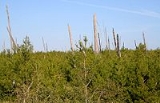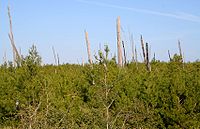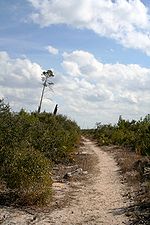
Juniper Prairie Wilderness
Encyclopedia
The Juniper Prairie Wilderness is a protected wilderness area in the Ocala National Forest
in Florida
, USA.
 The Juniper Prairie Wilderness was established in 1984 and covers an area of about 54 square kilometers (13,260 acres). It protects a diverse set of habitats including prairie
The Juniper Prairie Wilderness was established in 1984 and covers an area of about 54 square kilometers (13,260 acres). It protects a diverse set of habitats including prairie
, Longleaf
and Sand
Pine scrub
, marsh
es, subtropical palm
jungles, swamp
hardwoods, as well as sawgrass
. It also forms the drainage basin for the Juniper River. The headwaters of the Juniper River, Juniper Springs
, is a first magnitude artesian aquifer
, and is bounded within a national forest.
turn of the 20th century, human population on pats Island peaked with about a dozen families. The inhabitants supported themselves through farming, hunting, fishing, and trade along the St. Johns River. Because of the poor economic conditions, most inhabitants had left the area before it became part of the Ocala National Forest in
1908. In 1935, the last inhabitants abandoned the area after a settlement history of less than 100 years.
 The author Marjorie Kinnan Rawlings
The author Marjorie Kinnan Rawlings
visited the last two remaining inhabitants, Calvin and Mary Long in October 1933. She recorded the stories she was told on that occasion and other visits, which she
worked into her novel "The Yearling
" which was published in 1938 and won a Pulitzer Prize
in 1939. A movie of the same name was made based on the novel in 1946.
Ocala National Forest
The Ocala National Forest is the second largest National Forest in the U.S. state of Florida and covers approximately of Central Florida. It is located three miles east of Ocala and southeast of Gainesville...
in Florida
Florida
Florida is a state in the southeastern United States, located on the nation's Atlantic and Gulf coasts. It is bordered to the west by the Gulf of Mexico, to the north by Alabama and Georgia and to the east by the Atlantic Ocean. With a population of 18,801,310 as measured by the 2010 census, it...
, USA.
Area description

Prairie
Prairies are considered part of the temperate grasslands, savannas, and shrublands biome by ecologists, based on similar temperate climates, moderate rainfall, and grasses, herbs, and shrubs, rather than trees, as the dominant vegetation type...
, Longleaf
Longleaf Pine
Pinus palustris, commonly known as the Longleaf Pine, is a pine native to the southeastern United States, found along the coastal plain from eastern Texas to southeast Virginia extending into northern and central Florida....
and Sand
Sand Pine
Pinus clausa is a small, often shrubby tree from , exceptionally to tall, found in two separate locations, one across central peninsular Florida, and the other in the western Florida panhandle and the Alabama coast; there is a range gap of about between the populations...
Pine scrub
Florida scrub
Florida scrub is an endangered temperate coniferous forest ecoregion of the state of Florida in the United States. It is found on coastal and inland sand ridges and is characterized by a xeromorphic plant community dominated by shrubs and dwarf oaks. Scrub soils, a type of entisol, are derived...
, marsh
Marsh
In geography, a marsh, or morass, is a type of wetland that is subject to frequent or continuous flood. Typically the water is shallow and features grasses, rushes, reeds, typhas, sedges, other herbaceous plants, and moss....
es, subtropical palm
Arecaceae
Arecaceae or Palmae , are a family of flowering plants, the only family in the monocot order Arecales. There are roughly 202 currently known genera with around 2600 species, most of which are restricted to tropical, subtropical, and warm temperate climates...
jungles, swamp
Swamp
A swamp is a wetland with some flooding of large areas of land by shallow bodies of water. A swamp generally has a large number of hammocks, or dry-land protrusions, covered by aquatic vegetation, or vegetation that tolerates periodical inundation. The two main types of swamp are "true" or swamp...
hardwoods, as well as sawgrass
Cladium
Cladium is a genus of large sedges, with a worldwide distribution in tropical and temperate regions...
. It also forms the drainage basin for the Juniper River. The headwaters of the Juniper River, Juniper Springs
Juniper Springs
Juniper Springs Juniper Springs Juniper Springs (referred to locally as "the Springs", located in the Ocala National Forest east of Ocala, Florida, is a natural spring that forms the headwaters of Juniper Creek that winds its way to Lake George in the Saint Johns River.-Description:...
, is a first magnitude artesian aquifer
Artesian aquifer
An artesian aquifer is a confined aquifer containing groundwater under positive pressure. This causes the water level in a well to rise to a point where hydrostatic equilibrium has been reached. This type of well is called an artesian well...
, and is bounded within a national forest.
Settlement history
In the 1840's, Patrick Smith settled in the Juniper Prairie Wilderness in an area which became known as "Pats Island". Reuben Long and his family homesteaded in the area in 1872. Around theturn of the 20th century, human population on pats Island peaked with about a dozen families. The inhabitants supported themselves through farming, hunting, fishing, and trade along the St. Johns River. Because of the poor economic conditions, most inhabitants had left the area before it became part of the Ocala National Forest in
1908. In 1935, the last inhabitants abandoned the area after a settlement history of less than 100 years.
Literary impact

Marjorie Kinnan Rawlings
Marjorie Kinnan Rawlings was an American author who lived in rural Florida and wrote novels with rural themes and settings. Her best known work, The Yearling, about a boy who adopts an orphaned fawn, won a Pulitzer Prize for fiction in 1939 and was later made into a movie, also known as The...
visited the last two remaining inhabitants, Calvin and Mary Long in October 1933. She recorded the stories she was told on that occasion and other visits, which she
worked into her novel "The Yearling
The Yearling
The Yearling is a 1946 Technicolor family film drama made by MGM. It was directed by Clarence Brown and produced by Sidney Franklin. The screenplay was by Paul Osborn and John Lee Mahin , adapted from the novel of the same name by Marjorie Kinnan Rawlings...
" which was published in 1938 and won a Pulitzer Prize
Pulitzer Prize
The Pulitzer Prize is a U.S. award for achievements in newspaper and online journalism, literature and musical composition. It was established by American publisher Joseph Pulitzer and is administered by Columbia University in New York City...
in 1939. A movie of the same name was made based on the novel in 1946.

